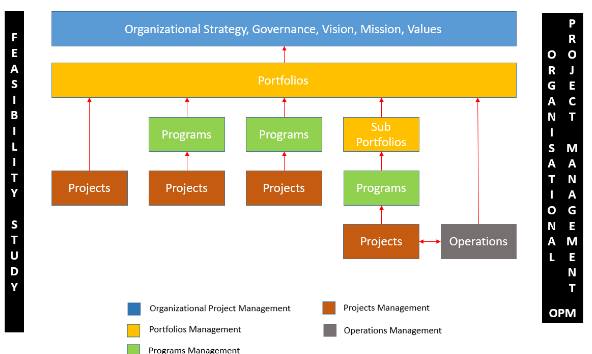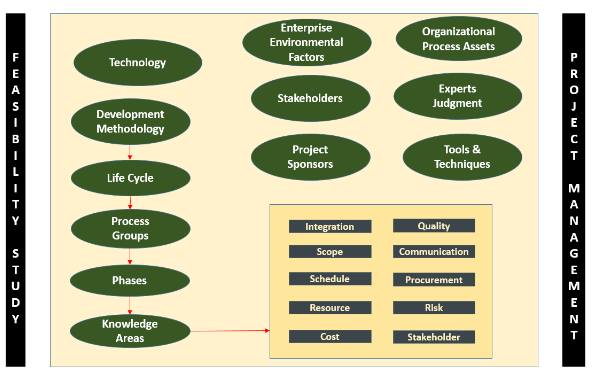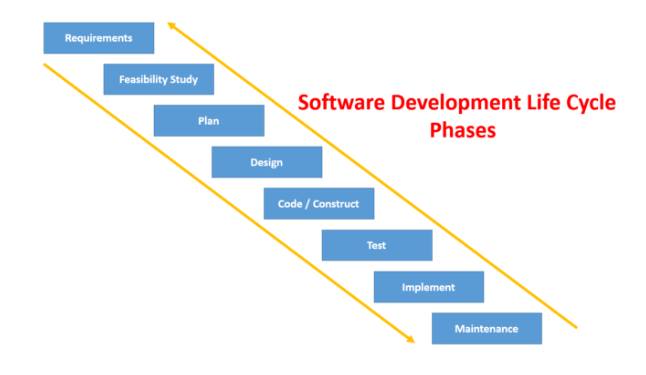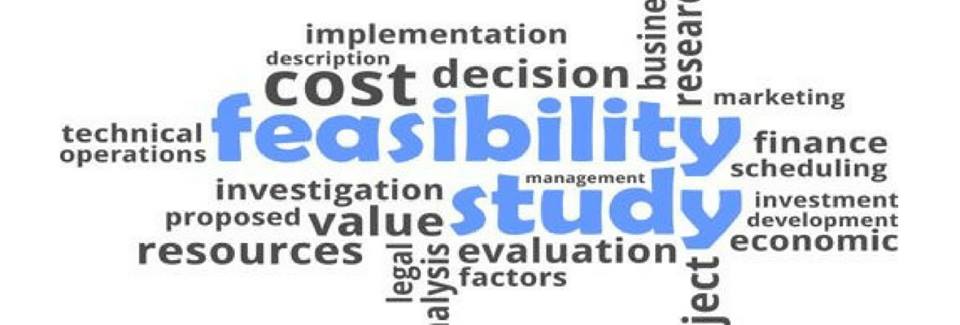Why, How and When to do a Feasibility study in Project Management
Introduction
We must always consider certain important factors before selecting or initiating a project in any industry. We call this a Feasibility Study for a project. It helps the organization to decide whether to start or reject the project.
What is the Feasibility Study?
It analyses whether the project aligns with the following factors of the performing business:
- Goals and Objectives
- Governance
- Standards
- Vision and Mission
- Project
- Program
- Portfolio
- Operations Management
- Enterprise Environmental Factors
- Organisational Process Assets
It also analyses whether the project meets the goals and objectives of:
- Project Sponsors
- End Users
- Customers
- Expert Judgment
- Stakeholders
When should we do a feasibility study of a project?
It happens during various stages of the project:
- Before submitting the response to the Proposal / Bid / Quotation / Tender Notice of the project.
- Before the initiation of the Project.
- While deciding to make or buy the product, services, and results.
Exploring the different areas of Feasibility Study
The feasibility study of a performing organization revolves around analyzing the feasibility of some of these areas:
- Vision & Mission
- Project Management
- Program Management
- Operations Management
- Portfolio Management
- Organizational Project Management, Strategy, and Governance
- Enterprise Environmental Factors
- Organizational Process Assets
- Technology Considerations

The different areas around which we conduct the feasibility study in a project during Project Management include:
- Integration Management
- Scope Management
- Schedule or Time Management
- Resource Management
- Cost Management
- Quality Management
- Communication Management
- Risk Management
- Procurement Management
- Stakeholder Management
These areas of feasibility study also involve other various entities of the organization, namely:
- Stakeholders
- Experts
- End Users
- Customers
- Project Sponsors

How to judge the need for a feasibility study in a project?
The Feasibility Study of a project helps the organization, project sponsors, customers, end-users, experts and stakeholders to predict the possible outcomes before initiating the project. Feasibility study helps them to decide whether to start or reject the project.
Steps to build a feasibility study in your project
Feasibility Study of the project must meet the goals and objectives of these aspects of a project:
a) Mission and Vision of an Organization:
A mission statement defines the goals and objectives of an organization. A vision statement defines the current and the desired position for the organization. The statements of Mission and Vision represents the purpose, values, goals, and objectives of an organization.
b) Project Management:
It deals with the knowledge, skills, processes, tools, and techniques applied to the activities of a project. It focuses on the interdependencies within a project.
The feasibility study with regard to the project management helps to:
- Achieve the objectives of the business.
- Meet the expectations of the stakeholders.
- Predict the outcomes.
- Increase the probabilities of success.
- Deliver the acceptable products on time.
- Provide resolution to the issues.
- Closes all the risks on time.
- Optimise the resources through resource leveling and smoothing.
- Execute the project towards success.
- Manage changes through the implementation of Change Control Procedures (CCP).
- Manage Triple Constraints.
The feasibility study in project management revolves around various phases and components of the project management processes, these include.
I) Project Life Cycle:
A project life cycle is the series of phases that a project passes through from its initiation to its completion. It provides the basic framework for managing the project. This basic framework applies regardless of the specific project work involved. The phases may be sequential, iterative or overlapping.

II) Development Life Cycle:
It contains phases within a project life cycle for the development of the products, services or results. It can be a predictive, iterative, incremental, adaptive or hybrid model.
III) Project Phases:
A project consists of distinct phases. The project phases include:
- Concept Development
- Feasibility Study
- Customer Requirements
- Solution Development
- Design
- Prototype
- Building
- Testing
- Transition
- Commissioning
- Milestone Review
- Lessons Learned
IV) Project Management Process Groups:
It consists of project management processes required to achieve specific objectives of the project. Process Groups are independent of project phases. There are five Project Management Process Groups:
- Initiating Process Groups
- Planning Process Groups
- Executing Process Groups
- Monitoring and Controlling Process Groups
- Closing Process Groups
V) Project Management Knowledge Areas:
There are ten major knowledge areas for managing the project:
- Project Integration Management
- Project Scope Management
- Project Schedule Management
- Project Cost Management
- Project Quality Management
- Project Resource Management
- Project Communications Management
- Project Risk Management
- Project Procurement Management
- Project Stakeholder Management
VI) Tools and Techniques:
These include the resources that process the inputs and transforms them into the desired outputs.
Project Management Knowledge Areas use the following tools and techniques:
- Data Gathering Techniques
- Data Analysis Techniques
- Data Representation Techniques
- Decision-Making Techniques
- Communication Skills
- Interpersonal and Team Skills
- Ungrouped Tools and Techniques
c) Program Management:
It deals with the knowledge, skills, and principles applied to the activities in a program. It focuses on the interdependencies between projects and programs.
d) Portfolio Management:
It deals with managing the projects, programs, subsidiary portfolios, and operations as a group. Portfolio management helps to achieve the various strategic goals of an organization.
e) Operations Management:
It deals with the ongoing activities of the production of goods and/or services. It ensures smooth functioning of the operations by using the required resources to meet the demands of the customer.
f) Organisational Project Management, Strategy, and Governance:
Organization Project Management (OPM) is a framework of portfolio, program and project management. It helps to achieve the strategic goals and objectives of an organization. Organizational governance deals with the management of people, policies, and processes. It helps to achieve the strategic and operational goals of the organization.
It ensures accountability, fairness, and transparency to its stakeholders. It may influence and impact the governance of projects, programs, and portfolios. Project governance is a framework used to create a unique product, service or result.
g) Enterprise Environmental Factors (EEFs):
It refers to the factors that impact the project but cannot be controlled or managed by the project team. EEFs can be internal or external.
h) Organizational Process Assets (OPAs):
They are various artifacts available in the organization which can be used in the project, for example, Plans, processes, policies, procedures and knowledge bases. These artifacts help to save time and effort in the project by reusing them.
i) Technology Considerations:
We must answer some of these questions in order to evaluate the technology for the project:
- Is the selected technology right for the project?
- Is it capable to handle the functional and non-functional requirements of the project?
- Will it reduce the cost?
- Will it ensure to complete the project on time?
j) Integration Management:
It deals with consolidating and coordinating the results among the knowledge areas to complete the project.
k) Scope Management:
It includes the processes which ensure that the project only includes the required work. It helps to meet the expectations of the customers and ensures the completion of the project results in success.
l )Schedule Management:
It involves the processes required to complete the project on time.
m) Resources Management:
It includes the processes required to manage the resources to complete the project on time.
n) Costs Management:
This involves the processes involved in managing the costs to complete the project within the approved budget.
o) Quality Management:
It consists of the processes that include the quality policy of the organization to meet the quality requirements of the project.
p) Communication Management:
It consists of processes that manage the timely flow of project information amongst the stakeholders.
q) Risks Management:
It involves the processes that help to manage the risks in a project thereby ensuring timely competition of the project.
r) Procurement Management:
It deals with the buying and making of resources or services for the project. This includes the processes to buy the products, services or results from outside the organization. It also consists of processes to make the products, services or results from within the organization. It also involves renting or leasing the resources required for the project.
s) Stakeholder Management:
This involves the processes to identify the people, groups or organizations which could impact the project or get affected by the project.
t) Experts Judgement:
Experts from various fields in the project management provide their valuable inputs for the project.
u) End Users:
End users focus and highlight the issues of the existing project. This helps in the enhancement of the project.
v) Project Management Office (PMO):
PMO includes the various structures in an organization which is involved in:
- Managing the project related governance processes.
- Facilitate the sharing of resources, methodologies, tools, and techniques.
There are several types of PMOs in an organization. Based on the degree of the control and their influence, PMOs can fall into any of these three categories:
- Controlling
- Supportive
- Directive
Controlling PMOs provide support and compliance required by the project.
Supportive PMOs acts as a consultant to projects by providing:
- Templates
- Best Practices
- Training
- Access to Information
- Lessons learned from previous projects.
Directive PMOs manage the projects. Project Managers report to directive PMOs.
w) Project Manager:
Project managers interact with the project members and stakeholders to complete their work.
They need the following interpersonal skills to ensure the project results in success:
- Leadership
- Team Building
- Motivation
- Communication
- Influence
- Decision Making
- Political and Cultural Awareness
- Negotiation
- Facilitation
- Manage Conflicts
- Training and Mentoring
How does feasibility study help in resolving organizational issues?
The output of Feasibility Study for Project Management is a Feasibility Study Report (FSR).
FSR includes the following information about the project:
- Introduction
- Background
- Requirements or Scope
- Schedule, Milestones, and Deliverables
- Resources
- Quality
- Cost
- Risks
- Procurement
- Stakeholders
- Alternatives and Options
- Dependencies
- Impediments
- Evaluation of Cost Benefits, Technical Solutions
- Conclusion
- Recommendations
The available information in the Feasibility Study Report (FSR) of the project helps the organization or project sponsors to:
- Predict the scope, time, resources and cost involved to develop the project.
- Manage the risks.
- Manage the stakeholders.
- Resolve the issues.
Advantages of using the feasibility study in Project Management
The advantages of the feasibility study in project management are:
- Helps to meet the objectives of the business.
- Helps to meet the expectations of the stakeholders.
- More predictability about the project.
- Increases the chances of project success.
- Delivers the right products at the right time.
- Resolves problems and issues much earlier.
- Responds to risks on time.
- Optimises the use of organizational resources.
- Helps to identify, recover or stop the failing projects.
- Manages constraints such as scope, quality, schedule, costs, resources)
- Aids in deciding whether to start or cancel the project.
Summary/Conclusion
The feasibility study in project management helps the organization and project sponsors to:
- Forecast the nature, size, and complexity of the project.
- Identify the benefits to the organization.
- Verify if the project aligns with the organizational strategy.
- Identify the scope, schedule, resources and cost to develop the project.
- Identify the risks, issues, dependencies, and Impediments.
- Verify if the proposed technology is correct for the project.
- Identify the organizational structure type for the project.
- Start or reject the project.
